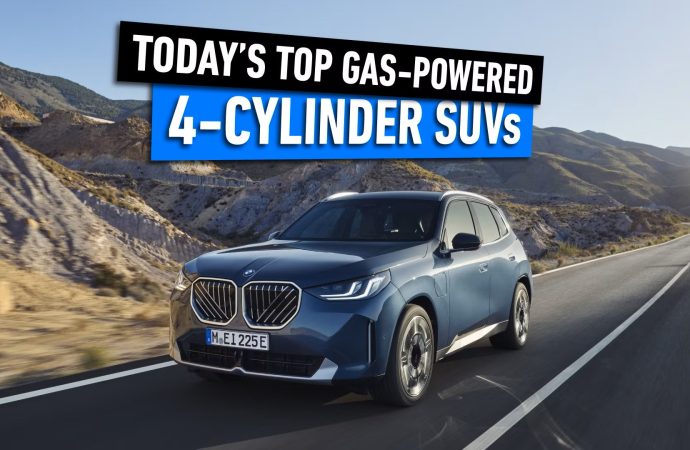Introduction SUVs are the go-to choice for many drivers who need space and versatility. But full-size, V6-powered models can guzzle fuel and cost more to maintain. That’s why 4 cylinder SUVs have surged in popularity. Today’s 2.0–2.5-liter four-cylinder engines deliver surprising power without the extra gas bills. Advanced turbocharging, direct injection, and mild-hybrid systems help
Introduction
SUVs are the go-to choice for many drivers who need space and versatility. But full-size, V6-powered models can guzzle fuel and cost more to maintain. That’s why 4 cylinder SUVs have surged in popularity. Today’s 2.0–2.5-liter four-cylinder engines deliver surprising power without the extra gas bills. Advanced turbocharging, direct injection, and mild-hybrid systems help these SUVs combine robust acceleration with impressive mileage. In this guide, we’ll highlight the top-rated 4 cylinder SUVs in 2025, explaining what makes each model stand out in terms of performance, efficiency, comfort, and value. Whether you commute daily or plan weekend getaways, there’s a four-cylinder SUV here for you.
Why Choose a 4 Cylinder SUV?
Before we dive into specific models, let’s look at why a four-cylinder makes sense in 2025:
- Fuel Efficiency: Smaller displacements plus turbocharging and hybrid assists often return 25–35 MPG combined.
- Lower Cost of Ownership: Four-cylinder engines cost less to build, insure, and repair than V6 units.
- Adequate Power: Turbocharged 2.0-liter engines now produce 200–275 hp, enough for most towing and passing needs.
- Environmental Benefits: Fewer cylinders mean lower CO₂ emissions, helping drivers meet stricter fuel-economy regulations.
- Improved Handling: Lighter front ends balance better, enhancing agility and cornering stability—key for urban and mountain roads.
With these advantages, today’s four-cylinder SUVs offer a compelling blend of performance and efficiency.
Selection Criteria
To choose our top-rated 2025 models, we focused on:
- Engine Performance: Horsepower, torque, and 0–60 mph times.
- Fuel Economy: EPA combined MPG or real-world consumption numbers.
- Cargo and Passenger Space: Room for families and weekend gear.
- Safety and Technology: Standard driver assists and infotainment.
- Reliability and Value: Predicted maintenance costs and resale hold.
Each SUV here meets or exceeds in at least three of these categories, making them smart buys in 2025.
Top-Rated 4 Cylinder SUVs in 2025
1. Honda CR-V Turbo (2.0L)
- Engine & Performance: The CR-V’s 1.5-liter turbo four makes 190 hp and 179 lb-ft of torque. Paired with a CVT, it hits 60 mph in about 8.2 seconds.
- Efficiency: EPA rates it at 28 city / 34 highway MPG, and real-world tests show 30 MPG on mixed drives.
- Space & Comfort: With 39.2 inches of rear legroom and 39.2 cubic feet of cargo space behind the rear seats, it swallows strollers and groceries easily.
- Safety & Tech: Honda Sensing suite—adaptive cruise, lane-keep assist, collision mitigation—is standard. The 7-inch touchscreen pairs with Apple CarPlay and Android Auto.
- Value & Reliability: Honda’s reputation for longevity and a predicted five-year cost of ownership under $28,000 make the CR-V a top pick.
2. Toyota RAV4 Prime (2.5L Hybrid)
- Engine & Performance: The RAV4 Prime combines a 2.5-liter four-cylinder with dual electric motors for 302 hp. 0–60 mph comes in 5.8 seconds blazing for an SUV.
- Efficiency: It achieves 38 MPGe in hybrid mode and up to 42 miles on electric alone.
- Space & Comfort: Cargo space remains a generous 33.5 cubic feet, with heated front seats and dual-zone climate.
- Safety & Tech: Toyota Safety Sense 2.5 covers pre-collision, auto high beams, and full-speed dynamic radar cruise control. The 8-inch display supports wireless smartphone mirroring.
- Value & Reliability: The plug-in hybrid system adds upfront cost but pays back through fuel savings and tax incentives. Toyota’s reliability ratings keep long-term costs low.
3. Mazda CX-5 2.5 Turbo
- Engine & Performance: Mazda’s 2.5-liter turbo four pumps out 256 hp (with premium fuel) and 320 lb-ft of torque. It delivers a sporty 0–60 mph in 6.1 seconds.
- Efficiency: EPA rates it at 22 city / 27 highway MPG—competitive for a turbo SUV. Real-world figures hover around 25 MPG.
- Space & Comfort: Leatherette seating, a driver-oriented cockpit, and 30.9 cubic feet behind the rear seats combine luxury with utility.
- Safety & Tech: Standard i-Activsense includes blind-spot monitoring, rear cross-traffic alert, and traffic-sign recognition on the head-up display.
- Value & Reliability: Mazda’s build quality and a premium feel create strong resale. Predicted five-year ownership costs align with non-luxury rivals.
4. Subaru Forester (2.5L)
- Engine & Performance: A naturally aspirated 2.5-liter four makes 182 hp and 176 lb-ft of torque. Subaru’s all-wheel drive and 8.7-second 0–60 mph time shine on rough roads.
- Efficiency: EPA numbers are 26 city / 33 highway MPG, with real-word tests confirming 30 MPG on average.
- Space & Comfort: 39.4 inches of rear legroom and a nearly flat load floor give 31.1 cubic feet of cargo space—ideal for gear and pets.
- Safety & Tech: EyeSight driver-assist tech includes lane centering, pre-collision braking, and adaptive cruise control. The 6.5-inch infotainment screen is simple but effective.
- Value & Reliability: With strong off-road capability and Subaru’s loyal following, resale values remain high, keeping ownership costs reasonable.
5. Ford Bronco Sport (2.0L Turbo)
- Engine & Performance: The Bronco Sport’s 2.0-liter EcoBoost four churns out 250 hp and 277 lb-ft of torque. Off the line, it reaches 60 mph in 7.1 seconds.
- Efficiency: EPA rates 21 city / 26 highway MPG. Real-world drivers report around 24 MPG.
- Space & Comfort: Unique cargo management system with 32.5 cubic feet behind the rear seats. Cloth Sport seats resist mud and moisture.
- Safety & Tech: Ford Co-Pilot360 offers lane-keeping, blind-spot alerts, and pre-collision assist. A 6-inch screen is standard, while a 9-inch touchscreen is optional.
- Value & Reliability: Bronco Sport appeals to adventure seekers. Its rugged look and genuine off-road chops boost its long-term appeal, though predicted service costs sit slightly above average.
Making Your Choice
All five 2025 4 cylinder SUVs blend power and efficiency in their own way. To decide:
- For Best Fuel Economy: Choose the Toyota RAV4 Prime hybrid.
- For Sporty Performance: The Mazda CX-5 turbo offers the quickest acceleration.
- For All-Road Capability: Subaru Forester’s standard AWD and ground clearance excel.
- For Adventure Style: Bronco Sport’s off-road gear and storage shine.
- For Overall Value: Honda CR-V balances efficiency, comfort, and running costs.
Consider your daily needs commutes, family size, weekend trips—and which SUV’s strengths match your lifestyle.
Conclusion
In 2025, 4 cylinder SUVs prove that you don’t need a big V6 to enjoy strong acceleration and versatile utility. From the hybrid power of the Toyota RAV4 Prime to the turbo grunt of the Mazda CX-5, these top-rated models offer a winning mix of performance, fuel savings, and modern tech. The Honda CR-V leads in value and reliability, while the Subaru Forester and Ford Bronco Sport cater to adventure and off-road fans. By focusing on fuel efficiency, space, safety, and ownership costs, you can find the perfect four-cylinder SUV for your daily drives and weekend getaways—combining power and efficiency without compromise.
















